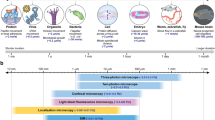Abstract
Fluorescence imaging could be the most powerful technique available for observing spatial and temporal dynamics of biomolecules in living cells, if fluorescent indicators for the relevant biomolecules become available. We have recently developed fluorescent indicators for a variety of second messengers or protein phosphorylations. Using the indicators, we have visualized spatial and temporal dynamics of these molecular events in single living cells. These fluorescent indicators are becoming an indispensable tool for understanding the complex mechanism of signal transduction in living cells.






Similar content being viewed by others
References
Tsien RY (1994) Fluorescence imaging creates a window on the cell. Chem Eng News 18:34–44
Hirano T, Kikuchi K, Urano Y, Higuchi T, Nagano T (2000) Novel zinc fluorescent probes excitable with visible light for biological applications. Angew Chem Int Ed 39:1052–1054
Kojima H et al (1998) Detection and imaging of nitric oxide with novel fluorescent indicators: diaminofluoresceins. Anal Chem 70:2446–2453
Tsien RY (1998) The green fluorescent protein. Annu Rev Biochem 67:509–544
Miyawaki A, Tsien RY (2000) Monitoring protein conformations and interactions by fluorescence resonance energy transfer between mutants of green fluorescent protein. Method Enzymol 327:472–500
Sato M, Umezawa Y (2004) Imaging protein phosphorylation by fluorescence in single living cells. Methods 32:451–455
Czech MP (2000) PIP2 and PIP3: complex roles at the cell surface. Cell 100:603–606
Cantley LC (2002) The phosphoinositide 3-kinase pathway. Science 296:1655–1657
Varnai P, Rother KI, Balla T (1999) Phosphatidylinositol 3-kinase-dependent membrane association of the Bruton’s tyrosine kinase pleckstrin homology domain visualized in single living cells. J Biol Chem 274:10983–10989
Venkateswarlu K, Gunn-Moore F, Tavare JM, Cullen PJ (1998) Nerve growth factor- and epidermal growth factor-stimulated translocation of the ADP ribosylation factor-exchange factor GRP1 to the plasma membrane of PC12 cells requires phosphatidylinositol 3-kinase and the GRP1 pleckstrin homology domain. Biochem J 335:139–146
Watton J, Downward J (1999) Akt/PKB localisation and 3′ phosphoinositide generation at sites of epithelial cell-matrix and cell-cell interaction. Cirr Biol 9:433–436
Sato M, Ueda Y, Takagi T, Umezawa Y (2003) Production of PtdInsP3 at endomembranes is triggered by receptor endocytosis. Nat Cell Biol 5:1016–1022
Zhang G, Kazanietz MG, Blumberg PM, Hurley JH (1995) Crystal structure of the Cys2 activator-binding domain of prortein kinase Cδ in complex with phorbol ester. Cell 81:917–924
Misra S, Miller GJ, Hurley JH (2001) Recognition of phosphatidylinositol 3-phosphate. Cell 107:559–562
Palmer RM, Ferrige AG, Moncada S (1987) Nitric oxide release accounts for the biological activity of endothelium-derived relaxing factor. Nature 327:524–526
Ignarro LJ, Buga GM, Wood KS, Byrns RE, Chaudhuri G (1987) Endothelium-derived relaxing factor produced and released from artery and vein is nitric oxide. Proc Natl Acad Sci USA 84:9265–9269
Ignarro LJ (ed) (2000) Nitric oxide: biology and pathobiology. Academic, London
Leone AM, Furst VW, Foxwell NA, Cellek S, Moncada S (1996) Visualisation of nitric oxide generated by activated murine macrophages. Biochem Biophys Res Commun 221:37–41
Yoshimura T et al (1996) In vivo EPR detection and imaging of endogenous nitric oxide in lipopolysaccharide-treated mice. Nat Biotechnol 14:992–994
Malinski T, Mesaros S, Tomboulian P (1996) Nitric oxide measurement using electrochemical methods. Methods Enzymol 268:58–69
Nagano T, Yoshimura T (2002) Bioimaging of nitric oxide. Chem Rev 102:1235–1269
Kojima H et al (2001) Bioimaging of nitric oxide with fluorescent indicators based on the rhodamine chromophore. Anal Chem 73:1967–1973
Gabe Y, Urano Y, Kikuchi K, Kojima H, Nagano T (2004) Highly sensitive fluorescence probes for nitric oxide based on boron dipyrromethene chromophore-rational design of potentially useful bioimaging fluorescence probe. J Am Chem Soc 126:3357–3367
Sasaki E et al (2005) Highly sensitive near-infrared fluorescent probes for nitric oxide and their application to isolated organs. J Am Chem Soc 127:3684–3685
Sato M, Hida N, Umezawa Y (2005) Imaging the nanomolar range of nitric oxide with an amplifier-coupled fluorescent indicator in living cells. Proc Natl Acad Sci USA 102:14515–14520
Koesling D, Russwurm M, Mergia E, Mullershausen F, Friebe A (2004) Nitric oxide-sensitive guanylyl cyclase: structure and regulation. Neurochem Int 45:813–819
Katsuki S, Arnold W, Mittal C, Murad F (1977) Stimulation of guanylate cyclase by sodium nitroprusside, nitroglycerin and nitric oxide in various tissue preparations and comparison to the effects of sodium azide and hydroxylamine. J Cyclic Nucl Res 3:23–35
Sato M, Hida N, Ozawa T, Umezawa Y (2000) Fluorescent indicators for cyclic GMP based on cyclic GMP-dependent protein kinase Ialpha and green fluorescent proteins. Anal Chem 72:5918–5924
Freyberger A, Ahr HJ (2004) Development and standardization of a simple binding assay for the detection of compounds with affinity for the androgen receptor. Toxicology 195:113–126
Sohoni P, Sumpter JP (1998) Several environmental oestrogens are also anti-androgens. J Endocrinol 158:327–339
Awais M, Sato M, Lee X, Umezawa Y (2004) A genetically encoded fluorescent indicator capable of discriminating estrogen agonists from antagonists in living cells. Anal Chem 76:2181–2186
Awais M, Sato M, Lee X, Umezawa Y (2006) A fluorescent indicator to visualize activities of the androgen receptor ligands in single living cells. Angew Chem Int Ed 45:2707–2712
Sato M, Ozawa T, Inukai K, Asano T, Umezawa Y (2002) Fluorescent indicators for imaging protein phosphorylation in single living cells. Nat Biotechnol 20:287–294
Sasaki K, Sato M, Umezawa Y (2003) Fluorescent indicators for Akt/Protein Kinase B and dynamics of Akt activity visualized in living cells. J Biol Chem 1:1–2
Acknowledgements
This work has been supported by JST Japan Science and Technology Agency and grants from the Ministry of Education, Science, and Culture of Japan, the Takeda Science Foundation, and the Sumitomo Foundation.
Author information
Authors and Affiliations
Corresponding author
Rights and permissions
About this article
Cite this article
Sato, M. Imaging molecular events in single living cells. Anal Bioanal Chem 386, 435–443 (2006). https://doi.org/10.1007/s00216-006-0716-7
Received:
Revised:
Accepted:
Published:
Issue Date:
DOI: https://doi.org/10.1007/s00216-006-0716-7




